Related Research Articles
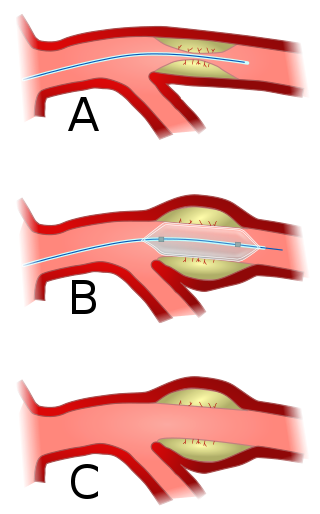
Angioplasty, also known as balloon angioplasty and percutaneous transluminal angioplasty (PTA), is a minimally invasive endovascular procedure used to widen narrowed or obstructed arteries or veins, typically to treat arterial atherosclerosis.
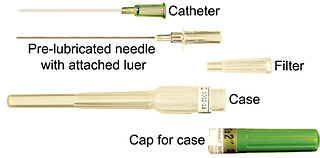
In medicine, a catheter is a thin tube made from medical grade materials serving a broad range of functions. Catheters are medical devices that can be inserted in the body to treat diseases or perform a surgical procedure. Catheters are manufactured for specific applications, such as cardiovascular, urological, gastrointestinal, neurovascular and ophthalmic procedures. The process of inserting a catheter is called catheterization.

In medicine, a stent is a tube usually constructed of a metallic alloy or a polymer. It is inserted into the lumen of an anatomic vessel or duct to keep the passageway open. Stenting refers to the placement of a stent. The word "stent" is also used as a verb to describe the placement of such a device, particularly when a disease such as atherosclerosis has pathologically narrowed a structure such as an artery.

Interventional radiology (IR) is a medical specialty that performs various minimally-invasive procedures using medical imaging guidance, such as x-ray fluoroscopy, computed tomography, magnetic resonance imaging, or ultrasound. IR performs both diagnostic and therapeutic procedures through very small incisions or body orifices. Diagnostic IR procedures are those intended to help make a diagnosis or guide further medical treatment, and include image-guided biopsy of a tumor or injection of an imaging contrast agent into a hollow structure, such as a blood vessel or a duct. By contrast, therapeutic IR procedures provide direct treatment—they include catheter-based medicine delivery, medical device placement, and angioplasty of narrowed structures.
In surgery, a percutaneous procedure is any medical procedure or method where access to inner organs or other tissue is done via needle-puncture of the skin, rather than by using an "open" approach where inner organs or tissue are exposed.

Vascular surgery is a surgical subspecialty in which vascular diseases involving the arteries, veins, or lymphatic vessels, are managed by medical therapy, minimally-invasive catheter procedures and surgical reconstruction. The specialty evolved from general and cardiovascular surgery where it refined the management of just the vessels, no longer treating the heart or other organs. Modern vascular surgery includes open surgery techniques, endovascular techniques and medical management of vascular diseases - unlike the parent specialities. The vascular surgeon is trained in the diagnosis and management of diseases affecting all parts of the vascular system excluding the coronaries and intracranial vasculature. Vascular surgeons also are called to assist other physicians to carry out surgery near vessels, or to salvage vascular injuries that include hemorrhage control, dissection, occlusion or simply for safe exposure of vascular structures.

Interventional cardiology is a branch of cardiology that deals specifically with the catheter based treatment of structural heart diseases. Andreas Gruentzig is considered the father of interventional cardiology after the development of angioplasty by interventional radiologist Charles Dotter.
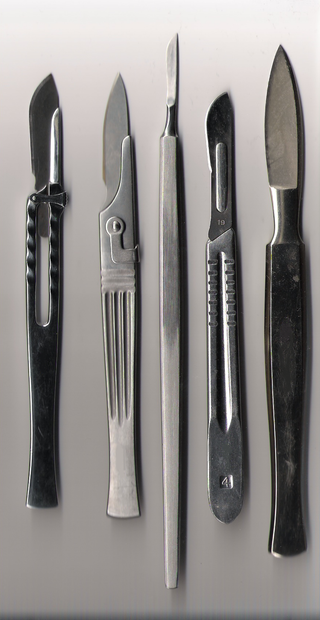
A surgical instrument is a medical device for performing specific actions or carrying out desired effects during a surgery or operation, such as modifying biological tissue, or to provide access for viewing it. Over time, many different kinds of surgical instruments and tools have been invented. Some surgical instruments are designed for general use in all sorts of surgeries, while others are designed for only certain specialties or specific procedures.

A drug-eluting stent (DES) is a tube made of a mesh-like material used to treat narrowed arteries in medical procedures both mechanically and pharmacologically. A DES is inserted into a narrowed artery using a balloon. Once the balloon inside the stent is inflated, the stent expands, pushing against the artery wall, keeping the artery open, thereby improving blood flow. The mesh design allows cells to grow through and around it, securing it in place.

Atrial septostomy is a surgical procedure in which a small hole is created between the upper two chambers of the heart, the atria. This procedure is primarily used to palliate dextro-Transposition of the great arteries or d-TGA, a life-threatening cyanotic congenital heart defect seen in infants. It is performed prior to an arterial switch operation. Atrial septostomy has also seen limited use as a surgical treatment for pulmonary hypertension. The first atrial septostomy was developed by Vivien Thomas in a canine model and performed in humans by Alfred Blalock. The Rashkind balloon procedure, a common atrial septostomy technique, was developed in 1966 by American cardiologist William Rashkind at the Children's Hospital of Philadelphia.
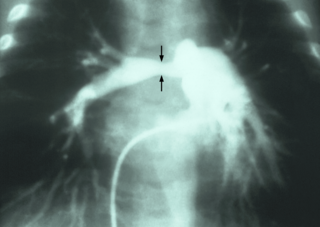
Pulmonary artery stenosis (PAS) is a narrowing of the pulmonary artery. The pulmonary artery is a blood vessel moving blood from the right side of the heart to the lungs. This narrowing can be due to many causes, including infection during pregnancy, a congenital heart defect, a problem with blood clotting in childhood or early adulthood, or a genetic change.
Embolectomy is the emergency interventional or surgical removal of emboli which are blocking blood circulation. It usually involves removal of thrombi, and is then referred to as thromboembolectomy or thrombectomy. Embolectomy is an emergency procedure often as the last resort because permanent occlusion of a significant blood flow to an organ leads to necrosis. Other involved therapeutic options are anticoagulation and thrombolysis.
Julio Palmaz is a doctor of vascular radiology at University of Texas Health Science Center at San Antonio. He studied at the National University of La Plata in Argentina, earning his medical degree in 1971. He then practiced vascular radiology at the San Martin University Hospital in La Plata before moving to the University of Texas Health and Science Center at San Antonio. He is known for inventing the balloon-expandable stent, for which he received a patent filed in 1985. It was recognized in Intellectual Property International Magazine as one of "Ten Patents that Changed the World" in the last century. His early stent research artifacts are now part of the medical collection of the Smithsonian Institution in Washington, DC. He continues to innovate on his initial designs, developing new endovascular devices.
Fogarty arterial embolectomy catheter is a device developed in 1961 by Dr. Thomas J. Fogarty to remove fresh emboli in the arterial system. It consists of a hollow tube with an inflatable balloon attached to its tip. The catheter is inserted into the blood vessel through a clot. The balloon is then inflated to extract the clot from the vessel. It is available in different lengths and sizes, and is often colour coded by size. Because it is less invasive than ordinary surgery, it reduces the chance of postoperative complications.
Todd E. Rasmussen, MD, FACS is an American professor and Vice Chair for Education in the Department of Surgery at Mayo Clinic, Rochester, and a Senior Associate Consultant in the Division of Vascular and Endovascular Surgery. Prior to joining the Mayo Clinic, he had a 28-year career in the military, retiring as an Air Force Colonel in 2021. His most recent military assignment was as Associate Dean or Research at the Uniformed Services University of the Health Sciences and an attending surgeon at the Walter Reed National Military Medical Center.

Dinker Belle Rai is an Indian American vascular surgeon who serves as the chairman of the Department of Surgery and as the Chief of the Department of Vascular Surgery / Vascular Laboratory at the Interfaith Medical Center, Brooklyn, New York. He is a visiting clinical professor at the Health & Science Center of the State University of New York in Brooklyn and a visiting professor at the Rajiv Gandhi University in Bangalore, India. Rai is a Fellow of the American College of Surgeons and a Fellow of the Royal Canadian College of Surgeons. He is credited with developing the first ever method for retrograde catheterization of the venous tree. This invention was given a United States patent in 1988. Based on this patent, a company called The Ideas For Medicine, Inc. manufactured and still distributes out a series of catheters, known as Rai’s Catheters for use in performing descending phlebographic tests and for venous embolectomies. He is also credited with the discovery of the motion of venous valves in human beings. His original research on histopathological specimens of patients with saphenofemoral – incompetency resulted in a paradigm shift in management of varicose veins. He performed the first ever vein transplantation below the knee. The discovery of the right atrial mechanical function is a pivotal discovery in his medical research work. He is an editor for the International Journal of Angiology. Rai has been featured in the book "Jewels of India" for his contributions to medicine, art, sports and cultural arenas.
Juan Carlos Parodi is an Argentinian vascular surgeon who introduced the minimally invasive endovascular aneurysm repair (EVAR) to the world and performed the first successful endovascular repair of an abdominal aortic aneurysm on 7 September 1990 in Buenos Aires. In 1992 he was the first in the United States to perform minimally invasive aortic aneurysm surgery together with Drs. Frank Veith, Michael L. Marin and Claudio J. Schonholz. He continues to develop new techniques, including seat belt and air bag technique for cerebral protection during carotid stenting. He is recognized as a renowned pioneer in the specialty of endovascular repairs of the aorta.
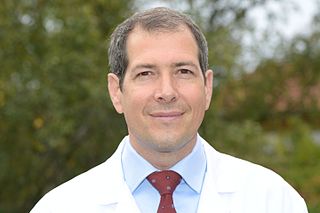
Christoph Huber MD, FMH, FECTS is a Swiss cardiac surgeon who is a professor and the head of the Division of Cardiac and Vascular Surgery at the University Hospital Geneva, Switzerland.
Cesare Gianturco was an Italian-American physician and one of the earliest contributors to the specialty of interventional radiology. After many years as the radiology chief at the Carle Clinic in Illinois and a faculty member at the University of Illinois College of Medicine, Gianturco moved to Houston, where he conducted research at MD Anderson Hospital.

LeMaitre Vascular is an American medical device company established in 1986 by vascular surgeon George D. LeMaitre, and based in Burlington, Massachusetts, which provides devices, implants and human tissue cryopreservation services used by surgeons in the treatment of vascular conditions, particularly peripheral vascular disease. As of 2022, LeMaitre Vascular sells directly to hospitals in 25 countries and through distributors in more than 70 countries throughout North America, Europe and Asia/Pacific Rim.
References
- ↑ "Dr. Thomas J. Fogarty". National Academy of Engineering . National Academy of Sciences . Retrieved 8 November 2021.
- ↑ "Dr. Thomas J. Fogarty Irish Roots | Irish American Museum of DC". www.irishamericanmuseumdc.org. Retrieved 2024-06-24.
- 1 2 3 Brown, David E (2003). "Thomas Fogarty: balloon embolectomy catheter". Inventing Modern America: From the Microwave to the Mouse . Cambridge, Mass.: MIT Press. pp. 12–17. ISBN 9780262025089.
- 1 2 "Thomas Fogarty | Lemelson-MIT Program". lemelson.mit.edu. Retrieved 2019-01-30.
- 1 2 3 4 5 Writer, John Flood-Town Crier Staff. "A Legend at Heart: Thomas Fogarty brings his inventive clout to El Camino Hopsital [sic]". Los Altos Town Crier. Retrieved 2019-01-30.
- 1 2 Riordan, Teresa (2000-05-22). "PATENTS; Two inventors honored for seminal work on the balloon catheter and wireless communications". The New York Times. ISSN 0362-4331 . Retrieved 2019-01-30.
- ↑ Brunk, Doug (November 15, 2006). "Physician Inventors Pioneer New Devices". www.mdedge.com. Retrieved 2019-01-30.
- 1 2 White, Tracie (Fall 2006). "Father of Invention. What's the master medical device maker's secret?". Stanford Medical Magazine.
- 1 2 3 Riggins, Christie (Fall 2000). "Great inventions don't happen overnight: development of the Fogarty balloon catheter". Stanford Medicine. 17 (3).
- 1 2 "Thomas J. Fogarty. 2012 National Medal of Technology and Innovation, Medicine". National Science & Technology Medals Foundation. Retrieved January 25, 2019.
- ↑ Hospital, Fogarty Institute for Innovation; El Camino. "Dr. Thomas J Fogarty Awarded Presidential National Medal of Technology and Innovation". www.prnewswire.com. Retrieved 2023-04-26.
{{cite web}}: CS1 maint: multiple names: authors list (link) - 1 2 "AdvaMed Honors Dr. Thomas J. Fogarty with Lifetime Achievement Award". Advanced Medical Technology Association. October 7, 2015. Retrieved January 25, 2019.
- ↑ "Thomas J. Fogarty M.D." Bloomberg. Retrieved January 25, 2019.
- ↑ Lenoir, Timothy (2014). "Inventing the entrepreneurial university: Stanford and the evolution of Silicon Valley". In Allen, Thomas J.; O'Shea, Rory P. (eds.). Building Technology Transfer within Research Universities: An Entrepreneurial Approach. Cambridge University Press. p. 110. ISBN 9780521876537.
- ↑ "Thomas J. Fogarty | The National Inventors Hall of Fame". www.invent.org. Retrieved 2019-01-30.
- ↑ "Thomas Fogarty, MD. Medical pioneer. Patent advocate". Fogarty Institute for Innovation. Retrieved January 25, 2019.
- ↑ "Under Vine". Thomas J. Fogarty Winery. Retrieved January 25, 2019.
- ↑ "The Wine & Spirits top 100 wineries of 2014". Wine & Spirits. October 3, 2014.